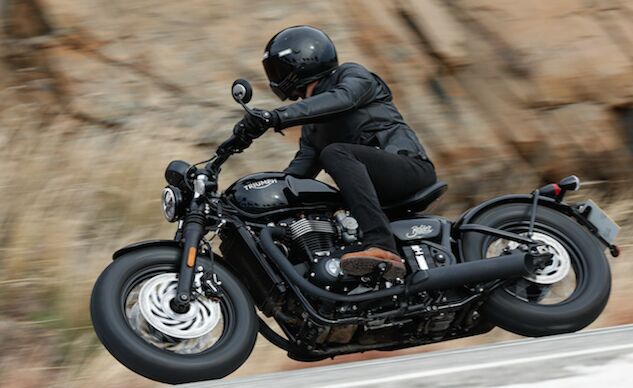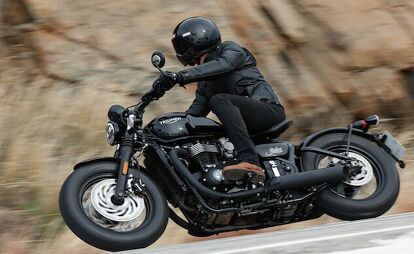2018 Triumph Bonneville Bobber Black First Ride Review
A juxtaposition of modern performance and old-school style
As technology races towards the future, style is moving the opposite direction, regressing to the past. Fortunately for us motorcyclists, the two aren’t mutually exclusive, which means we can have it both ways. Take the 2018 Triumph Bonneville Bobber Black, for instance – it’s a juxtaposition between modern technology and post-WWII style. The bobber style, for those of you who aren’t familiar, harkens back to the 1940s when American riders would get rid of anything they could to shed weight by cutting and removing bodywork and ‘bobbing’ the fenders. The desired effect was to be able to keep up with the lighter, faster British and Japanese bikes that began to flood American shores.
2018 Triumph Bonneville Bobber Black
| Engine | 18.0/20 |
| Suspension/Handling | 13.5/15 |
| Transmission/Clutch | 9.0/10 |
| Brakes | 8.5/10 |
| Instruments/Controls | 4.0/5 |
| Ergonomics/Comfort | 8.5/10 |
| Appearance/Quality | 8.75/10 |
| Desirability | 8.25/10 |
| Value | 8.0/10 |
| Overall Score | 86.5/100 |
Fast-forward 70 years and the bobber look is as timeless and popular as ever. This statement is backed up by Triumph’s Bonneville Bobber, which last year was the fastest selling model in Triumph’s 115-year history. While the regular, more gentleman-like Bobber is still available, Triumph is now also offering the Black, which as its name might suggest, is almost entirely dipped in – you guessed it! – black. Although color may be the biggest visual difference at a glance, the most significant change is an entirely updated front end.
The Bobber Black receives a beefed-up 47mm Showa cartridge fork over the Bobber’s 41mm KYB unit, twin 310mm discs bound by two-piston Brembo calipers instead of a single rotor with Nissin binders, and possibly the biggest visual difference (besides the color), a 16-inch fat front wheel, down from the 19-inch hoop found on the Bobber. Both the front and rear wheels are wrapped in Avon Cobra rubber specifically developed for the Black, measuring 130/90-16 and 150/80-16.
The goal of these updates over the standard Bobber was to elicit a more aggressive and muscular stance while simultaneously adding higher-spec performance upgrades. The 47mm Showa fork is non-adjustable and offers the same 3.5 inches of travel as the standard Bobber’s front end, however, the damping characteristics are noticeably improved, providing a more balanced and, dare I say, sportier ride. Discreetly hidden under the floating solo seat is a non-adjustable mono-shock with linkage that offers 3 inches of travel. While some adjustability settings would be nice, I found that the Black’s ride was surprisingly comfortable for all of my 180 pounds.
The Black’s suspension was plenty firm and offered a solid connection to, and feel for, the road but also soaked up the bigger hits without upsetting the bike’s balance. There was one particular bump in the road that almost all of us riders hit that surely should have rattled our sphincters, but to our pleasant surprise and relief, turned out to be just a slight hiccup. We were making our way up Ronda Road in southern Spain above Marbella, coming around a blind curve, traveling well above the posted speed-limit when BOOM!
There was an approximately 6-inch deep ridge across both lanes that was camouflaged into the road’s surface. None of us saw it, not even the lead rider from Triumph, but when we pulled off the road at the next stop, we drew the same conclusion and were surprised by how well the Black absorbed the hit and stayed on track. Kudos to the Triumph engineers for designing such a compliant suspension without any available adjustment.
Adding to the Black’s handling competence are the dual 310mm front rotors and two-pot Brembo calipers. The brake lever needed a firm initial squeeze, but the bike slowed down in quite the hurry as more pressure was applied. I think the fatter 130/90 front tire lent a helping hand with this, as there was that much bigger of a contact patch with the road over the standard Bobber’s skinnier 100/90 profile. Rear-wheel braking is handled by a 255mm rotor paired with a single-piston Nissin caliper. ABS comes standard front and rear, and to my pleasant surprise, works like it should, by only engaging when you really need it. The ABS isn’t invasive, premature or unsettling, and requires an abrupt, forceful pull on the lever – but once engaged, it only emits subtle modulation at the rider’s fingers – perfect.
Powering the Black is a 1200cc liquid-cooled, SOHC parallel-Twin with four valves per cylinder and a 270-degree firing interval. The motor is claimed to put out 77 hp at 6,100 rpm and 78.2 lb-ft at 4,000 rpm. Dubbed the HT, for High Torque, Triumph says the Black’s motor provides 10% more hp and torque than the Bonneville T120 at 4,500 rpm and 2% more peak torque. The motor has a very linear powerband and pulls with plenty of grunt off the bottom, continuing on up to the 6,900 rpm redline. The Black is happy to be lugged through corners and around town, though for sportier riding, both the rider and motor will be happier and reap more benefits while in the higher revs.
Two riding modes aid in keeping the Black greasy side down: road and rain, which we were able to test the effectiveness of as it had rained all night and morning, leaving many parts of the road still wet. Any sort of wheel spin was quickly quelled under heavy acceleration or abrupt throttle inputs. Additionally, you can also turn traction control off completely if you so desire. There’s enough torque to break the rear a little loose around town.
Cycling through the six gears is like buttah, and paired with a torque-assist clutch and ride-by-wire throttle, shifting is seamless and precise. Upshifts are nice, but downshifts with a blip of the throttle are even nicer, which is appreciated most during spirited riding. For 6-foot-1 me, the Black has a comfortable and commanding riding position – quite sporty for a cruiser. The broad, low bars and mid-control pegs allow you to really bend and twist the bike in and out of corners, however, the Black runs out of lean angle very quickly.
This is unfortunately my biggest gripe with the Black. Triumph didn’t provide specific angle measurement of cornering clearance, but scraping the pegs and exhaust happens sooner than many riders would like. This shortcoming is only brought about when riding more aggressively, but at the end of the day, the Black is a cruiser, not a canyon carving sportbike. Even so, we all know a motorcycle’s inner truths can only be unlocked by a heavy-handed jaunt through the twists. And the Black does boogie, even if negotiating turns requires more thought and calculation.
Speaking of cruising, the Black does it with ease thanks to its tall gear ratios. Cruising at 60 mph in sixth yields about 2,500 rpm, while 80 sees the motor spinning in the mid three’s, which leaves more than 3,000 extra revs to play with before reaching redline. With only a 2.4-gallon gas tank, cruising range could be better, but the Black’s instrumentation said we were getting almost 42 mpg during our ride, and that’s considering we were rarely “cruising.” You can expect better range under more normal operation.
The Bonneville Bobber Black offers a host of well thought out and appreciated touches that outshine and make up for its limitations. Some of these features include cruise control, which comes standard and is as easy as pushing the button twice – once to activate and again to set the speed. A third press of the button, or input on the brakes or throttle, cancels it. A seat height of 27.2 inches allows even the shortest of riders to easily put both feet on the ground, and the saddle can be moved forward or backwards about an inch total. I tried both settings but the difference seemed negligible for me, though vertically-challenged riders could certainly benefit from a shorter reach.
The overall fit and finish of the Black is quite impressive, with nary a single exposed cable or wire across the body of the bike, save for the handlebars. With its straight backbone, the frame has the old-school, hard-tailed bobber look, and even the twin throttle bodies have been designed to look like carburetors – a subtle but appreciated touch. Possibly my favorite feature of the bike are the bar-end mirrors. Not only do I think they look better than regular mirrors, they also work better by offering you more than the sight of your shoulders and elbows, and often vibrate less, too.
Additionally, staying true to the custom ethos of the Bonneville Bobber, Triumph already has a catalogue of more than 120 custom accessories for the Black. From handlebars to saddlebags and everywhere in between, owners can tailor their Black to better suit their style and needs.
Overall, the 2018 Triumph Bonneville Bobber Black is a rather well rounded motorcycle that seamlessly blends modern tech with old-school style. It provides ample performance by cruiser standards and is capable beyond its means. Triumph tells us we can expect the Black in dealerships this February with a base price of $13,150, and it’s available in two variants, Jet Black and Matte Jet Black ($250 more).
2018 Triumph Bonneville Bobber Black
+ Highs
- Sporty for a cruiser
- Buttery tranny
- Great attention to detail (clean uncluttered cockpit and nary a wire or cable in sight)
– Sighs
- Runs out of ground clearance quickly
- Non-adjustable suspension – some tweaking would be nice
- A cruise range limiting 2.4 gallon gas tank
2018 Triumph Bonneville Bobber Black Specifications | |
|---|---|
| Price | $13,150 for Jet Black / $13,400 for Matte Jet Black |
| Engine Type | Liquid-cooled SOHC Parallel twin cylinder; Four valves per cylinder |
| Bore and stroke | 97.6mm x 80mm |
| Capacity | 1200cc |
| Power (claimed) | 77 hp at 6,100 rpm |
| Torque (claimed) | 78.2 lb-ft at 4,000 rpm |
| Fuel system | Multipoint sequential electronic fuel injection |
| Final Drive | X-ring Chain |
| Front Suspension | 47mm non-adjustable Showa Cartridge fork; 3.5-in travel |
| Rear Suspension | KYB non-adjustable Mono-shock with linkage; 3-in travel |
| Front Brakes | Dual 310mm discs with two-piston axial mounted Brembo calipers; ABS |
| Rear brake | Single 255mm disc with single-piston axial mounted Nissin caliper; ABS |
| Wheels and Tires | Wire spoked steel rims; Front: 2.5”x16” Rear: 3.5”x16” Avon Cobra Front: 130/90 B16 AV71 Rear: 150/80 R16 AV72 |
| Saddle height | 27.2 inches |
| Rake | 25.8-degrees |
| Trail | 3.5 inches |
| Wheelbase | 59.4 inches |
| Curb Weight | 524 lbs (claimed) |
| Fuel Capacity | 2.4 gallons |
More by Brent Jaswinski






























































































Comments
Join the conversation
Compare this to the old bobber. Now I don't consider this Bobber to be a true Bobber since nothing has been bobbed. Anywsy, If triumph could get rid if some if the pricey gimmicks like cruise control and assisted braking, they might be able to set the msrp a little lower and interest me in buying one. I appreciate the beefier forks but would opt for the 19" wheel . And enuff with the black already! I would hope the 77 hp could brought up to 90 and then make it quite appealing.
Remember that "spy shot" of a Bonneville with upright ergos, speed triple-like headlights and the engine/suspension of the Thruxton? Whatever happened with that?